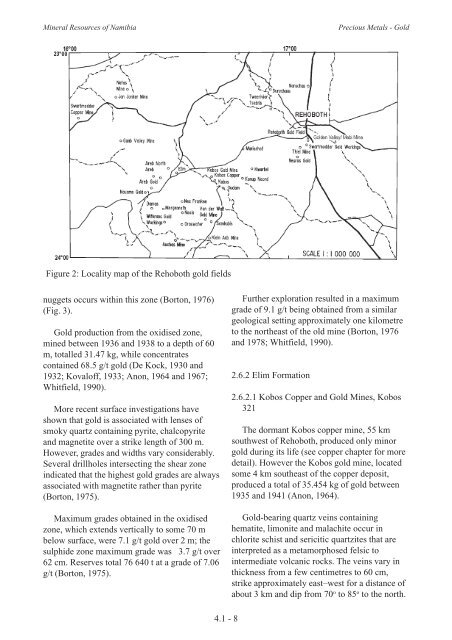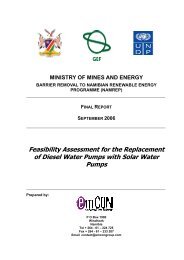Gold Chapter (855 KB) - Ministry of Mines and Energy
Gold Chapter (855 KB) - Ministry of Mines and Energy
Gold Chapter (855 KB) - Ministry of Mines and Energy
Create successful ePaper yourself
Turn your PDF publications into a flip-book with our unique Google optimized e-Paper software.
Mineral Resources <strong>of</strong> Namibia Precious Metals - <strong>Gold</strong><br />
Figure 2: Locality map <strong>of</strong> the Rehoboth gold fields<br />
nuggets occurs within this zone (Borton, 1976)<br />
(Fig. 3).<br />
<strong>Gold</strong> production from the oxidised zone,<br />
mined between 1936 <strong>and</strong> 1938 to a depth <strong>of</strong> 60<br />
m, totalled 31.47 kg, while concentrates<br />
contained 68.5 g/t gold (De Kock, 1930 <strong>and</strong><br />
1932; Koval<strong>of</strong>f, 1933; Anon, 1964 <strong>and</strong> 1967;<br />
Whitfield, 1990).<br />
More recent surface investigations have<br />
shown that gold is associated with lenses <strong>of</strong><br />
smoky quartz containing pyrite, chalcopyrite<br />
<strong>and</strong> magnetite over a strike length <strong>of</strong> 300 m.<br />
However, grades <strong>and</strong> widths vary considerably.<br />
Several drillholes intersecting the shear zone<br />
indicated that the highest gold grades are always<br />
associated with magnetite rather than pyrite<br />
(Borton, 1975).<br />
Maximum grades obtained in the oxidised<br />
zone, which extends vertically to some 70 m<br />
below surface, were 7.1 g/t gold over 2 m; the<br />
sulphide zone maximum grade was 3.7 g/t over<br />
62 cm. Reserves total 76 640 t at a grade <strong>of</strong> 7.06<br />
g/t (Borton, 1975).<br />
4.1 - 8<br />
Further exploration resulted in a maximum<br />
grade <strong>of</strong> 9.1 g/t being obtained from a similar<br />
geological setting approximately one kilometre<br />
to the northeast <strong>of</strong> the old mine (Borton, 1976<br />
<strong>and</strong> 1978; Whitfield, 1990).<br />
2.6.2 Elim Formation<br />
2.6.2.1 Kobos Copper <strong>and</strong> <strong>Gold</strong> <strong>Mines</strong>, Kobos<br />
321<br />
The dormant Kobos copper mine, 55 km<br />
southwest <strong>of</strong> Rehoboth, produced only minor<br />
gold during its life (see copper chapter for more<br />
detail). However the Kobos gold mine, located<br />
some 4 km southeast <strong>of</strong> the copper deposit,<br />
produced a total <strong>of</strong> 35.454 kg <strong>of</strong> gold between<br />
1935 <strong>and</strong> 1941 (Anon, 1964).<br />
<strong>Gold</strong>-bearing quartz veins containing<br />
hematite, limonite <strong>and</strong> malachite occur in<br />
chlorite schist <strong>and</strong> sericitic quartzites that are<br />
interpreted as a metamorphosed felsic to<br />
intermediate volcanic rocks. The veins vary in<br />
thickness from a few centimetres to 60 cm,<br />
strike approximately east–west for a distance <strong>of</strong><br />
about 3 km <strong>and</strong> dip from 70 o to 85 o to the north.




